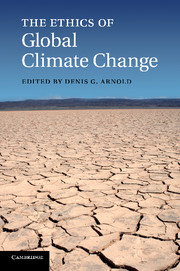Book contents
- Frontmatter
- Contents
- List of illustrations
- List of contributors
- Acknowledgements
- Introduction: climate change and ethics
- 1 Energy, ethics, and the transformation of nature
- 2 Is no one responsible for global environmental tragedy? Climate change as a challenge to our ethical concepts
- 3 Greenhouse gas emission and the domination of posterity
- 4 Climate change, energy rights, and equality
- 5 Common atmospheric ownership and equal emissions entitlements
- 6 A Lockean defense of grandfathering emission rights
- 7 Parenting the planet
- 8 Living ethically in a greenhouse
- 9 Beyond business as usual: alternative wedges to avoid catastrophic climate change and create sustainable societies
- 10 Addressing competitiveness in US climate policy
- 11 Reconciling justice and efficiency: integrating environmental justice into domestic cap-and-trade programs for controlling greenhouse gases
- 12 Ethical dimensions of adapting to climate change-imposed risks
- 13 Does nature matter? The place of the nonhuman in the ethics of climate change
- 14 Human rights, climate change, and the trillionth ton
- Select bibliography
- Index
- References
12 - Ethical dimensions of adapting to climate change-imposed risks
Published online by Cambridge University Press: 11 April 2011
- Frontmatter
- Contents
- List of illustrations
- List of contributors
- Acknowledgements
- Introduction: climate change and ethics
- 1 Energy, ethics, and the transformation of nature
- 2 Is no one responsible for global environmental tragedy? Climate change as a challenge to our ethical concepts
- 3 Greenhouse gas emission and the domination of posterity
- 4 Climate change, energy rights, and equality
- 5 Common atmospheric ownership and equal emissions entitlements
- 6 A Lockean defense of grandfathering emission rights
- 7 Parenting the planet
- 8 Living ethically in a greenhouse
- 9 Beyond business as usual: alternative wedges to avoid catastrophic climate change and create sustainable societies
- 10 Addressing competitiveness in US climate policy
- 11 Reconciling justice and efficiency: integrating environmental justice into domestic cap-and-trade programs for controlling greenhouse gases
- 12 Ethical dimensions of adapting to climate change-imposed risks
- 13 Does nature matter? The place of the nonhuman in the ethics of climate change
- 14 Human rights, climate change, and the trillionth ton
- Select bibliography
- Index
- References
Summary
Historical, present, and future emissions of greenhouse gases, principally through energy use, are altering the climate. Hence they are imposing harm and will impose harm in the future. This volume concentrates, rightly, on the ethical issues of stewardship, responsibility, and precaution that are relevant to questions of reducing emissions and avoiding climate change. But the remit of ethical questions relevant to the climate change challenge is wider: the ethics of science, evidence, and foresight; the ethics of public discourse and media; and the ethics of representation of the future and nonhumans, to name but a few. Here we examine issues around how society will adapt to a changing climate and its related impacts and challenges.
The impacts of human-induced climate change are with us, and in anticipation of future risks, adaptation to those changes is under way. While individuals and societies have always adapted to risks associated with changing climates and environments, adaptation to human-induced climate change is categorically different in that it involves the avoidance of harm imposed by others. In this chapter we explore the ethical issues raised by imposed harm and the need for sustainable adaptation. In particular, we explore the landscape of issues around the governance process and procedures by which climate justice for adaptation could potentially be implemented. We focus on the three issues of (1) identifying climate change adaptation; (2) identifying vulnerability; and (3) managing the responsibility for action.
- Type
- Chapter
- Information
- The Ethics of Global Climate Change , pp. 255 - 271Publisher: Cambridge University PressPrint publication year: 2011
References
- 7
- Cited by

